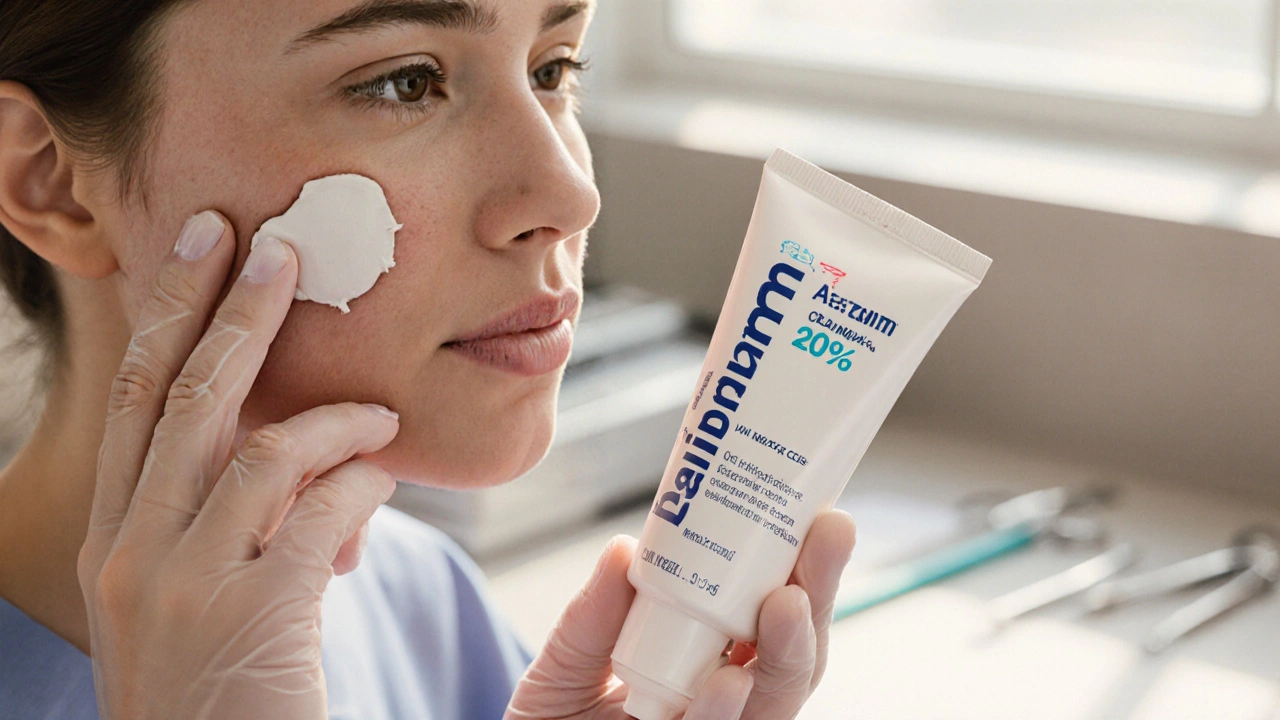Compare Aziderm Cream with top alternatives, see pros, cons, pricing, and a detailed side‑by‑side table to choose the best acne treatment for your skin.
Read more
When working with Azelaic Acid, a naturally occurring dicarboxylic acid that targets acne, rosacea and hyperpigmentation. Also known as Azelaic, it offers antibacterial, anti‑inflammatory and keratolytic actions, you instantly get a multi‑tasking tool that many dermatologists recommend. It’s especially effective against acne, inflamed breakouts caused by clogged pores and excess oil and can calm rosacea, redness and bumps that flare up with triggers like heat or stress. Plus, it fades hyperpigmentation, dark spots left behind after inflammation or sun damage. In short, Azelaic Acid bridges the gap between harsh prescription meds and gentle over‑the‑counter options.
Why does Azelaic Acid work so well? First, its antibacterial properties curb Propionibacterium acnes growth, which directly reduces new pimple formation. Second, it inhibits keratin production, keeping pores from clogging and softening existing lesions. Third, its anti‑inflammatory effect calms the skin’s immune response, cutting down redness for both acne and rosacea. Finally, it blocks tyrosinase, the enzyme that creates melanin, which helps even out skin tone over time. These four attributes—antibacterial, keratolytic, anti‑inflammatory, and melanin‑blocking—form the core of Azelaic Acid’s therapeutic profile.
Azelaic Acid comes in creams, gels, foams and prescription‑strength gels up to 20% concentration. Lower concentrations (10% or less) are perfect for beginners or sensitive skin, while higher strengths tackle stubborn acne or deep melasma. Apply a thin layer after cleansing, let it absorb for a few minutes, then follow with a moisturizer. Most users see improvement within 4‑6 weeks; patience is key because the ingredient works gradually, not like a quick‑fix bleach.
How does it stack up against other go‑to ingredients? Benzoyl peroxide, a strong oxidizing agent that kills acne‑causing bacteria fast can be harsher, often causing dryness and irritation. Retinoids, vitamin A derivatives that speed up cell turnover are powerful but may trigger redness, especially for rosacea‑prone skin. Salicylic acid, a beta‑hydroxy acid that exfoliates inside pores works well for oily skin but lacks the melanin‑blocking benefit. Azelaic Acid sits in the middle: gentle enough for sensitive users, yet strong enough to address both inflammation and discoloration without the harsh side‑effects of peroxide or retinoids.
When building a routine, consider combining Azelaic Acid with complementary products. A gentle, non‑comedogenic cleanser clears the stage for the treatment to work. A hydrating moisturizer containing ceramides or hyaluronic acid prevents barrier disruption. If sun exposure is a concern, pair it with a broad‑spectrum SPF 30+; the pigment‑lightening action can make skin more sensitive to UV rays. For nighttime, some people add a niacinamide serum to boost barrier repair and further soothe redness.
People often wonder if they can use Azelaic Acid on other body areas. The answer is yes—it's safe on the chest, back and even the décolletage, as long as the skin there can tolerate the concentration. For extensive acne on the back (often called “bacne”), a 10% gel applied after showering works well. For melasma on the face, a prescription‑strength 15‑20% product used under a dermatologist’s guidance can speed up fading.
Side effects are generally mild: occasional tingling, temporary dryness or a faint peeling. If irritation spikes, cut back to every other night or switch to a lower concentration. Always patch‑test on a small area before full‑face use. And remember, consistency beats occasional over‑use; steady application yields the best results without blowing the skin’s natural barrier.
In practice, Azelaic Acid fulfills three semantic triples that matter to anyone battling skin issues: Azelaic Acid reduces acne lesions, Azelaic Acid lightens hyperpigmentation, and Azelaic Acid calms rosacea redness. These relationships guide how you layer it with other actives and decide when to seek professional advice.
Now that you’ve got the basics—what it is, why it works, how to pick a strength, and how it fits alongside other ingredients—you’re ready to explore the deeper dive articles below. Whether you’re after a step‑by‑step routine, a cost‑comparison of generic options, or the latest clinical insights, the collection ahead covers every angle of Azelaic Acid use. Let’s keep the conversation going and help you achieve clearer, smoother skin without breaking the bank.

Compare Aziderm Cream with top alternatives, see pros, cons, pricing, and a detailed side‑by‑side table to choose the best acne treatment for your skin.
Read more